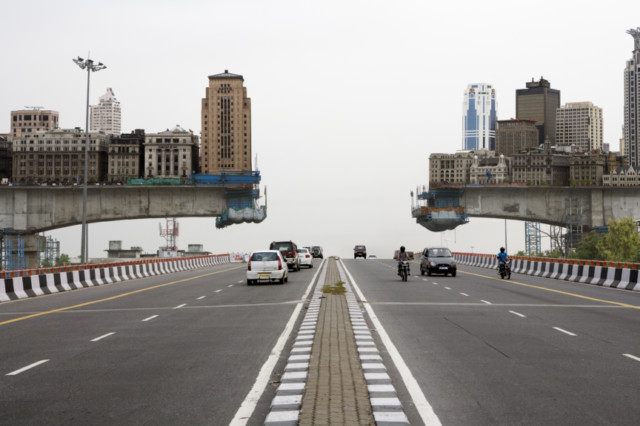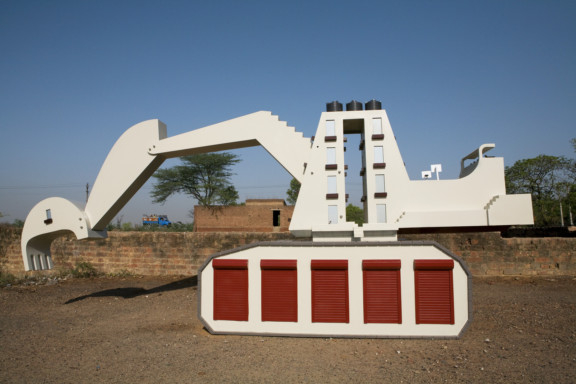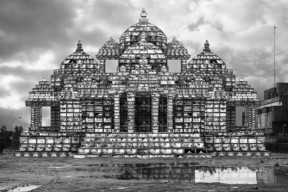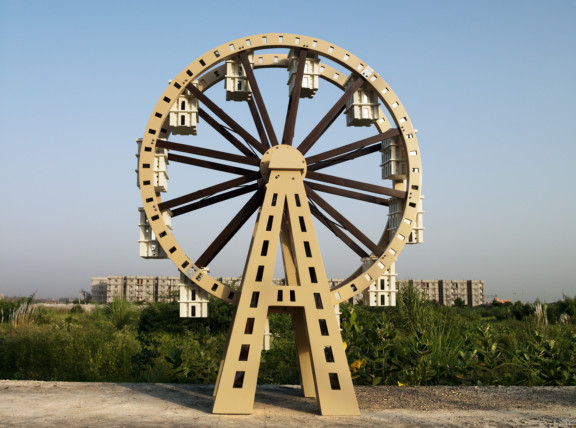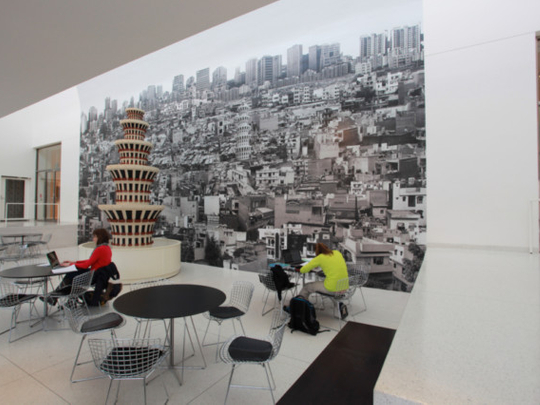
Indian contemporary artist Gigi Scaria considers public art as a way of unpacking his own notions of what builds art and creativity, and he uses inspired cityscapes as the medium. “Each time you think about a specific location conceptually as well as in practice you need to challenge your existing knowledge about how an artwork ‘works’. Taking that challenge excites me more than anything else,” says Scaria, who taught art in a public school for many years, before becoming a full-time artist in 2006.
In a recent interactive session at Artry Dubai, Scaria presented his video project titled “City Unclaimed”. It was Scaria’s project for the Smart Museum of Art, University of Chicago. Set up in 2013, the components of the project includes a large photo-based mural of an imaginary Delhi cityscape and a 3.6-metre-high fountain.
Through it, Scaria attempts to start a dialogue about architectural spaces, class, social disparities and the scarce resources in urban settings.
The artist uses different mediums in his works such as painting, photography, installations, sculptures and video art.
“Public art has tremendous potential to attract a larger viewership for art. It should be engaging enough for people to come closer and have a look, as well as thought-provoking so that it can engage them intellectually for a longer period of time. Whenever I think of a public-art project or I am invited to do one, I also think about the local stories and connections associated with the area where the artwork has to be placed and I incorporate these ideas which are relevant to that locality,” Scaria says.
Scaria can see clearly why public art is in demand. “Contemporary art is not a new term. Public art has existed ever since artists started exhibiting their art works in public areas permanently or temporarily. Contemporary means what happens in the present time — this term is not only used for art, it is also applicable to any field, such as music, literature, dance, architecture, etc. Certainly the making of public art is gathering momentum because it deals with the time we live in,” the artist says.
Scaria has been interested in art from childhood. “I started my practice when I was able to hold a pencil or a pen in my hand. My grandmother was a major inspiration for me those days as I curiously got involved in making small sculptures and drawings. During various stages of my life, many people, mostly philosophers and writers, influenced me to think and act from different perspectives. I may not be able to talk about a particular individual who helped me to do what I am doing but an amalgamation of different knowledge systems and my own thinking process contributed to my views on art,” says Scaria, whose works are now showing across the map — mainland Europe, United Kingdom, the United States, Middle East, Australia, Trinidad & Tobago, Brazil, Israel, South Korea, Thailand, India, China and Bangladesh.
Patience and persistence has brought him thus far in his artistic career and he tells young aspiring artists that “art is a journey, a lifelong engagement. One may feel depressed at times when things are not turning out the way they should be. But stay inspired, for the future unfolds as a response to the art practice you do.”
Scaria enjoyed working with Smart Museum. “Smart Museum was really a great experience. My artwork [a huge wall paper and a sculpture in front] was installed there for a year and people loved the ambience and the feel. They were also engaged in conversations about the work most of the time,” the artist says. The project was the result of a year-long discussion with Jessica Moss, the curator.
The installation, which was placed at the cafeteria of Smart Museum, has two sections that make for sculptural and digital extravagance. Photographs of Delhi have been manipulated to create an imaginary cityscape that has its own complex cultural logic.
“These images are from various parts of the city, keeping in mind the stark difference in the layers of social and economic classes that exist there. It also closely looks into and dissects the character of a megapolis. When an imaginary city is made based on real facts, it generates a set of meanings, which in this particular case explores the irony and sarcasm of a social framework and its architectural/physical spaces,” Scaria says.
The second part of the installation is a fountain, which stands in front of the digital wall. The fountain is made out of apartment blocks and appears to have been inspired by the general architectural look of the city on the wall. “This fountain projects the scarcity and the abundance of water in the city. It poses the issues of sewerage water, dead rivers and polluted water bodies in and around a city on one hand and the ignorance about the wastage of water by the public and private sectors on the other. When we observe the drastic changes and the scarcity of natural resources in the world we realise that urbanisation has had a big role to play in bringing us to this situation,” the artist says.
Fountains are the urban inventions to facilitate access to natural sources. But in the present urban context, with the polluted waterbodies, fountains have become the metaphors of a glorious past and reminders of the troubles ahead. Placing a city and a fountain next to each other creates a dialogue between man-made disaster and a natural calamity.
“I have been observing the city of Delhi for 16 years. It is this engagement that helped formulate my perception of urban spaces in India. The layers of social structures and hierarchies one encounters in a single day in Delhi may prompt thoughts on what India must be like. The urban and the rural, the class and the cast, religion and practice, and the endless list of eccentric and idiosyncratic exchanges between different social groups somehow create their own mystery in any urban space in India. For us [Indians], modernity is a big claim, which has to be approved and contextualised at every stage of any discourse. On the other hand, an economically booming India, representing the vast middle class on its side, is constantly erasing and redrawing the map of the country with a completely different set of tools and calculations. The repercussions and resonance of these new voices have also been woven into the urban fabric with a variety of architectural and cultural forms. The new construction fever and mall culture could be a result of this phenomenon,” Scaria says.
“City Unclaimed” looks at the eccentricities nurtured in a typical Indian urban setting largely created and run by a migrant population. Each part of the city claims its immediate vicinity but overall it lies unattended and unclaimed by any system or logic. It grows and decays by its own logic, assigned by the mood of the time.
Kochi next
Scaria is gearing up for a large-scale site-specific installation for the Kochi-Muziris Biennale, which opens on December 12. Eighty artists from 26 countries will be participating in the biennale’s second edition, which will be curated by Indian artist Jitish Kallat. The last edition drew 400,000 visitors over a three-month period.
Scaria’s “Chronicle of the Shores Foretold” will be an 18-foot-high installation made of stainless steel, motorised pump system, wood and rope. The installation will be complemented by an event performed by Mappila Khalasis.
Again, as with public art, Scaria is pushing the envelope here. The proposed Kochi installation, “preferably behind Aspinwall”, where it caresses the backwaters, will have a Promethean undertow, of human will and labour resisting the vagaries of time and the vicissitudes of the gods. “The act of labour has always been associated with being a step ahead of creating a future of our own. On the other hand, every action committed by human effort is an act against the boredom of existence,” he says.
Scaria’s installation is based on a folklore. “Every shore on the Arabian Sea tells a local story of an enormously huge bell brought by sea from Europe to be installed in a church; unfortunately, the ship sinks in the sea due to the heaviness of the bell. But every year, during the church festival, the bell emerges from the sea and rings on its own. The connection between the powerful deity and its colonial origin is maintained by this miracle,” Scaria says.
The project also speaks of different aspects of human labour. “The physical effort has been reduced to the lowest because of the advancement of this trend. The effort for an action now exists only in the mind. But the local version of the basic labour and its will to move the unmoveable somehow rekindles the strength of the labour in the most inhuman times of ours,” Scaria says.
Known as artist B’lu, Archana R. D. is a freelance writer based in Dubai. She is also a student of global art business with the Sotheby’s.


